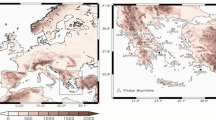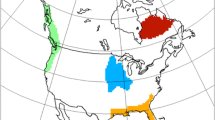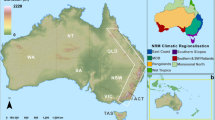Abstract
The study examines simulation of atmospheric circulation, represented by circulation indices (flow direction, strength and vorticity), and links between circulation and daily surface air temperatures in regional climate models (RCMs) over Central Europe. We explore control simulations of five high-resolution RCMs from the ENSEMBLES project driven by re-analysis (ERA-40) and the same global climate model (ECHAM5 GCM) plus of one RCM (RCA) driven by different GCMs. The aims are to (1) identify errors in RCM-simulated distributions of circulation indices in individual seasons, (2) identify errors in simulated temperatures under particular circulation indices, and (3) compare performance of individual RCMs with respect to the driving data. Although most of the RCMs qualitatively reflect observed distributions of the airflow indices, each produces distributions significantly different from the observations. General biases include overestimation of the frequency of strong flow days and of strong cyclonic vorticity. Some circulation biases obviously propagate from the driving data. ECHAM5 and all simulations driven by ECHAM5 underestimate frequency of easterly flow, mainly in summer. Except for HIRHAM, however, all RCMs driven by ECHAM5 improve on the driving GCM in simulating atmospheric circulation. The influence on circulation characteristics in the nested RCM differs between GCMs, as demonstrated in a set of RCA simulations with different driving data. The driving data control on circulation in RCA is particularly weak for the BCM GCM, in which case RCA substantially modifies (but does not improve) the circulation from the driving data in both winter and summer. Those RCMs with the most distorted atmospheric circulation are HIRHAM driven by ECHAM5 and RCA driven by BCM. Relatively strong relationships between circulation indices and surface air temperatures were found in the observed data for Central Europe. The links differ by season and are usually stronger for daily maxima than minima. RCMs qualitatively reproduce these relationships. Effects of the driving model biases were found on RCMs’ performance in reproducing not only atmospheric circulation but also the links to surface temperature. However, the RCM formulation appears to be more important than the driving data in representing the latter. Differences of the circulation-to-temperature links among the RCA simulations are smaller and the links tend to be more realistic compared to the driving GCMs.








Similar content being viewed by others
References
Blenkinsop S, Jones PD, Dorling SR, Osborn TJ (2009) Observed and modelled influence of atmospheric circulation on central England temperature extremes. Int J Clim 29(11):1642–1660
Christensen JH, Christensen OB, Lopez P, van Meijgaard E, Botzet M (1996) The HIRHAM4 regional atmospheric climate model. Scientific Report 96–4. The Danish Meteorological Institute, Copenhagen
Christensen JH, Kjellström E, Giorgi F, Lenderink G, Rummukainen M (2010) Weight assignment in regional climate models. Clim Res 44(2–3):179–194
Demuzere M, Werner M, van Lipzig NPM, Roeckner E (2009) An analysis of present and future ECHAM5 pressure fields using a classification of circulation patterns. Int J Clim 29(12):1796–1810
Flocas HA, Hatzaki M, Tolika K, Anagnostopoulou C, Kostopoulou E, Giannakopoulos C, Kolokytha E, Tegoulias I (2011) Ability of RCM/GCM couples to represent the relationship of large scale circulation to climate extremes over the Mediterranean region. Clim Res 46:197–209
Furevik T, Bentsen M, Drange H, Kindem IKT, Kvamstø NG, Sorteberg A (2004) Description and evaluation of the bergen climate model: ARPEGE coupled with MICOM. Clim Dyn 21:27–51
Giorgi F, Bi X, Pal J (2004) Means, trends and interannual variability in a regional climate change experiment over Europe. Part I: Present day climate (1961–1990). Clim Dym 22:736–756
Gordon C, Cooper C, Senior CA, Banks H, Gregory HM, Johns TC, Mitchell JFB, Wood RA (2000) The simulation of SST, sea ice extent and ocean heat transports in a version of the Hadley Centre coupled model without flux adjustments. Clim Dyn 16:147–168
Haylock MR, Hofstra N, Klein Tank AMG, Klok EJ, Jones PD, New M (2008) A European daily high-resolution gridded data set of surface temperature and precipitation for 1950–2006. J. Geophys Res 113:D20119. doi:10.1029/2008JD010201
Hewitt C, Griggs D (2004) Ensembles-based predictions of climate changes and their impacts. EOS 85:566. doi:10.1029/2004EO520005
IPCC (2007) Climate Change 2007: the physical science basis. Contribution of working group I to the IPCC fourth assessment report. Cambridge University Press, Cambridge
Jacob D (2001) A note to the simulation of the annual and inter-annual variability of the water budget over the Baltic Sea drainage basin. Meteorol Atmos Phys 77:61–73
Jacob D, Bärring L, Christensen OB, Christensen JH, de Castro M et al (2007) An inter-comparison of regional climate models for Europe: model performance in present-day climate. Clim Change 81:31–52
Jenkinson AF, Collison FP (1977) An initial climatology of gales over the North Sea. Synoptic Climatology Branch Memorandum No. 62, Meteorological Office, Bracknell, UK
Kjellström E, Barring L, Gollvik S, Hansson U, Jones C et al (2005) A 140-year simulation of European climate with the new version of the Rossby Centre regional atmospheric climate model (RCA3). SMHI reports meteorology and climatology Vol. 108, SMHI, SE-60176. Norrköping, Sweden, p 54
Kjellström E, Nikulin G, Hansson U, Strandberg G, Ullerstig A (2011) 21st century changes in the European climate: Uncertainties derived from an ensemble of regional climate model simulations. Tellus 63A:24–40
Kyselý J (2008) Influence of the persistence of circulation patterns on warm and cold temperature anomalies in Europe: analysis over the 20th century. Global Planet Change 62:147–163
Kyselý J, Plavcová E (2010) A critical remark on the applicability of E-OBS European gridded temperature data set for validating control climate simulations. J Geophys Res 115:D23118. doi:10.1029/2010JD014123
Lenderink G, van der Hurk B, van Meijgaard E, van Ulden A, Cujipers H (2003) Simulation of present day climate in RACMO2: first results and model developments. KNMI, technical report 252, pp 24
Lorenz P, Jacob D (2010) Validation of temperature trends in the ENSEMBLES regional climate model runs driven by ERA40. Clim Res 44(2–3):167–177
Maraun D, Osborn TJ, Rust HW (2011) The influence of synoptic airflow on UK daily precipitation extremes. Part I: Observed spatio-temporal relationships. Clim Dyn 36(1):261–275
Moberg A, Jones PD (2004) Regional climate model simulations of daily maximum and minimum near-surface temperatures across Europe compared with observed station data 1961–1990. Clim Dyn 23(7–8):695–715
Osborn TJ, Hulme M (1997) Development of a relationship between station and grid-box rainday frequencies for climate model evaluation. J Clim 10(8):1885–1908
Osborn TJ, Conway D, Hulme M, Gregory JM, Jones PD (1999) Air flow influences on local climate: observed and simulated mean relationships for the United Kingdom. Clim Res 13:173–191
Pfeiffer A, Zängl G (2011) Regional climate simulations for the European Alpine Region-sensitivity of precipitation to large-scale flow conditions of driving input data. Theor Appl Climatol 105(3):325–340. doi:10.1007/s00704-010-0394-4
Plavcová E, Kyselý J (2011) Evaluation of daily temperatures in Central Europe and their links to large-scale circulation in an ensemble of regional climate models. Tellus 63A:763–781. doi:10.1111/j.1600-0870.2011.00514.x
Roeckner E, Brokopf R, Esch M, Giorgetta M, Hagemann S et al (2006) Sensitivity of simulated climate to horizontal and vertical resolution in the ECHAM5 atmosphere model. J Clim 19:3771–3791
Samuelsson P, Jones CG, Willen U, Ullerstig A, Gollvik S et al (2011) The Rossby centre regional climate model RCA3: Model description and performance. Tellus 63A:4–23
Sanchez-Gomez E, Somot S, Déque M (2009) Ability of an ensemble of regional climate models to reproduce weather regimes over Europe-Atlantic during the period 1961–2000. Clim Dyn 33:723–736
Turnpenny JR, Crossley JF, Hulme M, Osborn TJ (2002) Air flow influences on local climate: comparison of a regional climate model with observations over the United Kingdom. Clim Res 20:189–202
Uppala SM, Kallberg PW, Simmons AJ, Andrae U et al (2005) The ERA-40 re-analysis. Q J R Meteorol Soc 131:2961–3012
van der Linden P, Mitchell JFB (eds) (2009) ENSEMBLES: climate change and its impacts: summary of research and results from the ENSEMBLES project. Met Office Hadley Centre, Exeter, p 160
van Ulden AP, van Oldenborgh GJ (2006) Large-scale atmospheric circulation biases and changes in global climate model simulations and their importance for climate change in Central Europe. Atmos Chem and Phys 6:863–881
van Ulden A, Lenderink G, Van Den Hurk B, Van Meijgaard E (2007) Circulation statistics and climate change in Central Europe: PRUDENCE simulations and observations. Clim Change 81:179–192
Wilks DS (1995) Statistical methods in the atmospheric sciences. San Diego, Academic Press
Acknowledgments
The authors are grateful to P. Štěpánek, Czech Hydrometeorological Institute, Brno, for providing the gridded observed data, and to anonymous referees for comments that helped improve the original manuscript. The RCM and GCM data were obtained from the ENSEMBLES project database funded within the EU-FP6, contract number 505539. The study was supported under project P209/10/2265 funded by the Czech Science Foundation.
Author information
Authors and Affiliations
Corresponding author
Appendices
Appendices
1.1 Appendix 1: Circulation indices
The airflow indices are calculated using MSLP in the grid points shown in Fig. 1 (left).
Flow strength is the total net westerly w and southerly s flow:
The westerly (zonal) component of the geostrophic surface wind is calculated as the pressure gradient between 45°N and 55°N and represents the westerly flow w:
The southerly (meridional) component of the geostrophic surface wind represented by the pressure gradient between 10°E and 20°E is the southerly flow s:
The direction of flow DIR is calculated as
added 180° if s ≥ 0, and 360° if s < 0 or w ≥ 0.
The total shear vorticity VORT is the sum of the westerly and southerly vorticities:
where zw corresponds to the difference of the westerly flow between 40°N and 50°N and of that between 50°N and 60°N
and zs is the difference of the southerly flow between 30°E and 20°E and of that between 10°E and 0°E
The constants used in these equations reflect the different sizes of grid cells at each latitude.
1.2 Appendix 2: Confidence intervals
The 95% confidence interval in Fig. 2 is calculated using the formula described by Wilks (1995):
where p is the sample proportion (best estimate of the binomial event probability), z α/2 stands for the 2.5% quantile of the normal distribution, and n is the sample size.
Rights and permissions
About this article
Cite this article
Plavcová, E., Kyselý, J. Atmospheric circulation in regional climate models over Central Europe: links to surface air temperature and the influence of driving data. Clim Dyn 39, 1681–1695 (2012). https://doi.org/10.1007/s00382-011-1278-8
Received:
Accepted:
Published:
Issue Date:
DOI: https://doi.org/10.1007/s00382-011-1278-8




